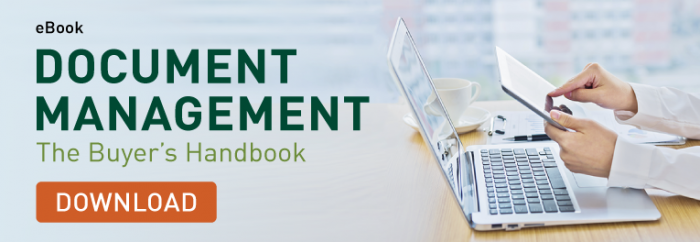A digital filing system, as you might expect, primarily serves the purpose of converting your more traditional filing systems, such as filing cabinets and stacks of folders, into a digital format that makes it easier to search for and store documents.
An enterprise content management (ECM) system does everything digital filing system software can do and more. It adds additional layers of security, administration and collaboration that make it ideal for offices that want to become not only more organized, but also more scalable and efficient.
Read on for an in-depth look at what a digital filing system and an ECM system have in common, as well as what makes an ECM system a more robust option for organizations that need it.
Scanning Documents and Gathering Metadata
One of the most obvious advantages of any digital system is the ability to scan and capture digital or paper documents. Digital filing systems can reduce clutter and create more space around the office, while being able to store documents almost indefinitely, which can be crucial for the proper preservation of historical records.
Along with being able to scan documents, most digital filing systems allow users to fill out information about each entry frequently referred to as metadata that makes content more searchable and thus easy to find. This can include anything from time stamps to receipt amounts and invoice numbers, information that many organizations find essential for business operations.
Compared to a standard digital filing system, quality ECM systems include optical character recognition (OCR) technology, which can pull information directly from a document to auto-generate its associated metadata. For example, accounts payable departments across industries regularly process invoices and compare them to purchase orders sent out to vendors. With OCR, they would be able to streamline the matching process, and with the help of other technologies, likely create an entirely automated process.
Search and Storage
A key advantage of a digital filing system over a paper one is the ability to more easily search for documents. In a digital filing system, you can search for documents based on name, contents and associated metadata. Digital folders are also incredibly more flexible than physical ones, being able to expand with your organization’s needs.
ECM solutions go beyond simply making documents easy to find and store, however. ECM systems also make information easier to share and keep track of, with features such as co-authoring and version control. Most enterprises face challenges dealing with collaboration whether multiple teams need to sign off on a document or work together, documents can be lost or contain errors if communication isn’t a priority. The collaboration features of ECM help teams collectively agree on the formatting and content of documents, while version controls assist in efforts to provide an accurate history of them. This is a boon for highly regulated industries, such as finance. An ECM solution can support these firms in their efforts to stay in compliance while providing their own staff and auditors up-to-date and correct information.
Ease of Access
With so many devices at the disposal of today’s users, most digital filing systems feature a variety of ways to access their content. A digital filing system may include different clients for desktop, web and even mobile. This is a boon for expanding enterprises as it keeps documents, ideas and projects moving.
Of course, the more accessible information is, the harder it is to control what is public or private. However, ECM systems offer tools to restrict or open up document access to meet your organization’s needs. For example, if you’re a government agency that needs to retain transparency, you can host a public portal with an ECM system that supports compliance with FOIA and allows constituents to stay informed about agency projects, initiatives, meeting minutes and more. On the other hand, the same agency can use an ECM system to restrict access to confidential documents, such as staff records.
Choosing the Best Solution for You
Although a digital system can fulfill many of your organization’s needs and facilitate the move towards a paperless office, the right enterprise content management system may be your best solution as it can offer even more benefits.
With the ability to pull data from scanned documents, foster collaboration and provide the tools to support compliance, ECM can help your organization more clearly manage its information in order to propel itself towards success.
This article was originally published on the Laserfiche Blog. Laserfiche is a leading SaaS provider of intelligent content management and business process automation.

